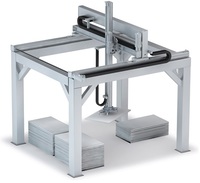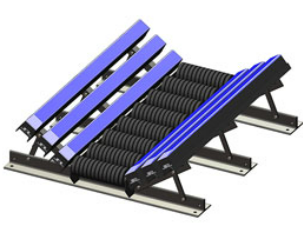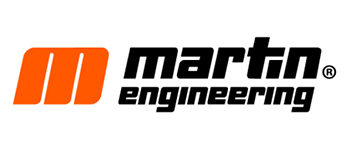
Material Handling
Material handling is the key to having good warehouse management. Material handling is not only the handling of inventory; it is the movement, protection, storage, and control of materials through all the phases in the chain, from manufacturing to warehousing to distribution, consumption, and disposal.
We offer a wide range of ready and custom-made casters and wheels, lifting systems such as hydraulic lifters, lifting columns, and screw jack lifters, as well as a variety of industrial electric vibrators including foot-mounted, flanged, mechanical, and high-frequency.
HVH Industrial works with the specialized engineering teams of manufacturers to meet our customer's requirements and the highest quality standards.
If you have any questions, write us via live chat (one of our team members will answer your questions), give us a call, or send us a quote request. The HVH team is always ready to help you.
 1(866)577-4040
1(866)577-4040
or
Material Handling
Manufacturers
What is Material Handling
Material handling is the process of moving, packing, storing, and controlling materials within a facility or between facilities. From the movement and protection of products during manufacturing to distribution and disposal, material handling is a critical aspect of the overall process.
Categories of Material Handling
Material handling systems can be divided into two main categories: manual and automated. Manual material handling systems involve the use of manual labor and tools to move materials from one place to another such as hand trucks, pallet jacks, and other simple tools to move materials. Manual material handling systems are typically used in warehouses and other locations where the volume of materials being moved is low and the materials are relatively light in weight.
Automated material handling systems are designed to move materials quickly and efficiently from one part of a facility to another. Typically, automated systems involve the use of powered conveyors, robotic arms, and other automated equipment to move materials. Automated systems are often used in high-volume processing and manufacturing environments, where speed and accuracy are of the utmost importance.
Advantages of Material Handling
The advancement of material handling technologies has revolutionized the industry, leading to reduced costs, improved safety, and enhanced speed and accuracy in material movement. Automated systems, in particular, are becoming increasingly prevalent in industries such as manufacturing, medical, and industrial.
Material handling equipment increases efficiency and productivity by streamlining the process of moving materials, which helps to cut down on the amount of time and labor required to perform a task and increase profits for businesses.
Material handling equipment help to increase safety in the workplace. Companies can lower the risk of employee injuries and completely eliminate the possibility of product damage as a result of careless handling by utilizing the appropriate equipment.
Proper storage solutions, including storage racks, bins, shelving, and the like, also fall under the umbrella of material handling. Ensuring proper storage practices is crucial to prevent damage to materials and equipment, while also making them readily accessible when needed.
Material Handling Types
We offer a wide range of material handling equipment, such as casters, wheels, and conveyor systems.
Casters and Wheels
Casters and wheels are the components that allow material handling equipment, such as carts, dollies, and trucks, to move easily and smoothly. Casters are the housing unit that contains the wheel, axle, and bearings, while wheels are the round-shaped components that make contact with the ground. Together, they form a unit that can rotate around a vertical axis and swivel in any direction.
Casters and wheels come in various sizes, load capacities, and materials. The choice of caster and wheel materials depends on the application, environment, and load requirements
The three main types of casters are swivel, rigid, and total locking casters.
Swivel Casters
Swivel casters are designed to rotate 360 degrees, making them ideal for applications that require maneuverability. They are available in various sizes and configurations, with load capacities ranging from light-duty to heavy-duty. Footmaster swivel casters come with locking mechanisms that prevent the wheels from turning, providing stability when needed.
Rigid Casters
Rigid casters are designed to move in a straight line, making them ideal for applications that require stability and precision. They are available in various sizes and configurations, with load capacities ranging from light-duty to heavy-duty. Footmaster rigid casters come with shock-absorbing technology.
Total Locking Casters
Total locking casters provide both swivel and brake functionality, allowing for easy movement and stability when needed. The total locking feature locks both the wheel and swivel simultaneously, providing maximum stability and security.
Footmaster wheels are a type of caster wheel designed for industrial and commercial applications where heavy equipment or machinery needs to be moved or repositioned frequently. They are known for their high load-bearing capacity, stability, and ease of maneuverability. Footmaster wheels are typically made of durable materials such as steel, nylon, or polyurethane, and come in a variety of sizes and weight capacities to accommodate different types of equipment.
Casters and wheels are typically made of steel, rubber, plastic, or polyurethane. The type of caster or wheel chosen depends on the weight, size, and type of material being moved. Steel casters and wheels are the most durable and are typically used for heavy-duty applications, while rubber and plastic casters and wheels are more lightweight and are best for light-duty applications. Polyurethane casters and wheels are best for applications that require shock absorption and quiet operations.
Conveyor Systems
Conveyor systems are an integral part of any manufacturing, mining, or material handling operation. They facilitate the efficient movement of goods and raw materials, helping to increase productivity while reducing labor costs. Conveyor idlers, conveyor pulleys, and pulley laggings are three critical components of conveyor systems that play a significant role in ensuring the smooth and safe operation of the system.
Conveyor idlers are cylindrical rollers that support the conveyor belt and guide it along the conveyor frame. They are typically arranged in sets or pairs, with one roller located at each end of the roller bed. Idlers come in various designs, including trough, impact, and return idlers. They are manufactured from various materials, including steel, plastic, and rubber. The selection of the right idler depends on several factors, including the weight of the load, conveyor speed, belt width, and operating conditions.
Conveyor pulleys are cylindrical drums that are mounted on shafts and used to support and guide the conveyor belt. They are used to transmit power from the conveyor motor to the belt and are critical in maintaining the tension and alignment of the belt. Pulleys come in various designs, including drive, tail, snub, and bend pulleys. They are manufactured from various materials, including steel, aluminum, and composite materials.
Pulley laggings are coverings that are applied to the surface of conveyor pulleys to improve the grip between the pulley and the conveyor belt. Laggings are used to prevent slipping and misalignment of the belt and can be made from various materials, including rubber, ceramic, and polyurethane. The selection of the right lagging depends on several factors, including the conveyor system's operating conditions, belt speed, and the type of material being conveyed.
Industrial Electric Vibrators
Electric vibrators are used in a wide range of industries, including construction, mining, food processing, and pharmaceuticals. They are used to shake and compact materials, facilitate the flow of powders and solids, and aid in the separation of materials. Electric vibrators are an efficient and effective means of creating vibrations in a controlled manner.
How do Electric Vibrators Work
Electric vibrators use an electric motor to generate a rotational force. This force is transferred to an eccentric weight that is attached to the motor shaft. As the motor spins, the weight rotates and generates a centrifugal force. This force causes the entire device to vibrate, creating the desired effect.
The frequency and amplitude of the vibration can be adjusted by changing the speed of the motor or the weight of the eccentric weight. Electric vibrators can produce vibrations at a wide range of frequencies and amplitudes, making them suitable for a variety of applications.
Types of Electric Vibrators
Electric vibrators can be classified into two broad categories: rotary electric vibrators and linear electric vibrators.
Rotary Electric Vibrators
Rotary electric vibrators are devices that generate a rotating motion that is used to move or transport various materials. They are commonly used in industries such as construction, agriculture, and mining to move bulk materials such as sand, gravel, and minerals. Rotary electric vibrators are available in different sizes and models, depending on the size and weight of the material being transported.
Linear Electric Vibrators
Linear electric vibrators are devices that generate a linear motion that is used to compact or screen various materials. They are commonly used in industries such as food processing, pharmaceuticals, and chemicals to compact or screen materials such as powders, granules, and liquids. Linear electric vibrators are available in different sizes and models, depending on the size and type of material being processed.
In conclusion, Material handling systems are designed with the purpose of boosting productivity, cutting costs, and enhancing safety. The main objective of these systems is to move products from one point to another in the most efficient and cost-effective manner possible. They can be used to transfer materials and goods from the warehouse to the production line, or from the production line to the end customer and also ensure organized and safe storage of materials, goods, and products.






























